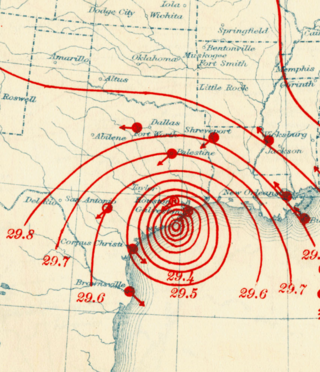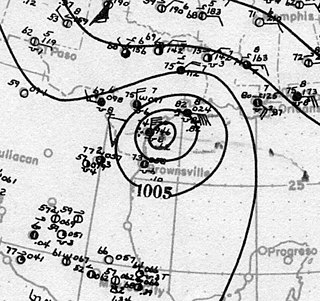
"Jump Jim Crow", often shortened to just "Jim Crow", is a song and dance from 1828 that was done in blackface by white minstrel performer Thomas Dartmouth "Daddy" Rice. The song is speculated to have been taken from Jim Crow, a physically disabled enslaved African-American, who is variously claimed to have lived in St. Louis, Cincinnati, or Pittsburgh. The song became a 19th-century hit and Rice performed it all over the United States as "Daddy Pops Jim Crow".

The 1900 Galveston hurricane, also known as the Great Galveston hurricane and the Galveston Flood, and known regionally as the Great Storm of 1900 or the 1900 Storm, is the deadliest natural disaster in United States history. The strongest storm of the 1900 Atlantic hurricane season, it left between 6,000 and 12,000 fatalities in the United States; the number most cited in official reports is 8,000. Most of these deaths occurred in and near Galveston, Texas, after the storm surge inundated the coastline and the island city with 8 to 12 ft of water. It remains among the deadliest Atlantic hurricanes on record. In addition to the number killed, the storm destroyed about 7,000 buildings of all uses in Galveston, which included 3,636 demolished homes; every dwelling in the city suffered some degree of damage. The hurricane left approximately 10,000 people in the city homeless, out of a total population of fewer than 38,000. The disaster ended the Golden Era of Galveston, as the hurricane alarmed potential investors, who turned to Houston instead. In response to the storm, three engineers designed and oversaw plans to raise the Gulf of Mexico shoreline of Galveston Island by 17 ft (5.2 m) and erect a 10 mi (16 km) seawall.
"Hush, Little Baby" is a traditional lullaby, thought to have been written in the Southern United States. The lyrics are from the point of view of a parent trying to appease an upset child by promising to give them a gift. Sensing the child's apprehension, the parent has planned a series of contingencies in case their gifts don't work out. The simple structure allows more verses to be added ad lib. It has a Roud number of 470.

Indianola is a ghost town located on Matagorda Bay in Calhoun County, Texas, United States. The community, once the county seat of Calhoun County, is a part of the Victoria, Texas, Metropolitan Statistical Area. In 1875, the city had a population of 5,000, but on September 15 of that year, a powerful hurricane struck, killing between 150 and 300 and almost destroying the town. Indianola was rebuilt, only to be wiped out on August 19, 1886, by another intense hurricane followed by a fire. Indianola was designated a Recorded Texas Historic Landmark in 1963, marker number 2642.

"Goodnight, Irene" or "Irene, Goodnight," is a 20th-century American folk standard, written in 3
4 time, first recorded by American blues musician Huddie 'Lead Belly' Ledbetter in 1933. A version recorded by the Weavers was a #1 hit in 1950.
"Foggy Dew" or "Foggy, Foggy Dew" is an English folk song with a strong presence in the South of England and the Southern United States in the nineteenth century. The song describes the outcome of an affair between a weaver and a girl he courted. It is cataloged as Laws No. O03 and Roud Folk Song Index No. 558. It has been recorded by many traditional singers including Harry Cox, and a diverse range of musicians including Benjamin Britten, Burl Ives, A.L. Lloyd and Ye Vagabonds have arranged and recorded popular versions of the song.
"Banks of the Ohio", also known as "Down on the Banks of the Ohio" and "I'll Never Be Yours", is a 19th-century murder ballad, written by unknown authors. The lyrics tell of "Willie" who invites his young lover for a walk during which she rejects his marriage proposal, and once they are alone on the river bank, he murders the young woman.

Eric Von Schmidt was an American folk musician and painter. He was associated with the folk boom of the late 1950s and early 1960s and was a key part of the Cambridge folk music scene. As a singer and guitarist, he was considered to be the leading specialist in country blues in Cambridge at the time, the counterpart of Greenwich Village's Dave Van Ronk. Von Schmidt co-authored with Jim Rooney Baby, Let Me Follow You Down: The Illustrated Story of the Cambridge Folk Years.

"Old Dan Tucker," also known as "Ole Dan Tucker," "Dan Tucker," and other variants, is an American popular song. Its origins remain obscure; the tune may have come from oral tradition, and the words may have been written by songwriter and performer Dan Emmett. The blackface troupe the Virginia Minstrels popularized "Old Dan Tucker" in 1843, and it quickly became a minstrel hit, behind only "Miss Lucy Long" and "Mary Blane" in popularity during the antebellum period. "Old Dan Tucker" entered the folk vernacular around the same time. Today it is a bluegrass and country music standard. It is no. 390 in the Roud Folk Song Index.
"Little Sadie" is a 20th-century American folk ballad written in Dorian mode. It is also known variously as "Bad Lee Brown", "Cocaine Blues", "Transfusion Blues", "East St. Louis Blues", "Late One Night", "Penitentiary Blues" and other titles. It tells the story of a man who is apprehended after shooting a woman, in some versions his wife or girlfriend. He is then sentenced by a judge.

The 1915 Galveston hurricane was a tropical cyclone that caused extensive damage in the Galveston area in August 1915. Widespread damage was also documented throughout its path across the Caribbean Sea and the interior of the United States. Due to similarities in strength and trajectory, the storm drew comparisons with the deadly 1900 Galveston hurricane. While the newly completed Galveston Seawall mitigated a similar-scale disaster for Galveston, numerous fatalities occurred along unprotected stretches of the Texas coast due to the storm's 16.2 ft (4.9 m) storm surge. Overall, the major hurricane inflicted at least $30 million in damage and killed 403–405 people. A demographic normalization of landfalling storms suggested that an equivalent storm in 2005 would cause $68.0 billion in damage in the United States.
"Rock Island Line" is an American folk song. Ostensibly about the Chicago, Rock Island and Pacific Railroad, it appeared as a folk song as early as 1929. The first recorded performance of "Rock Island Line" was by inmates of the Arkansas Cummins State Farm prison in 1934.
"I Know You Rider" is a traditional blues song that has been adapted by numerous artists. It has appeared in folk, country, and rock guises.
"Dink's Song" is an American folk song played by many folk revival musicians such as Pete Seeger, Fred Neil, Bob Dylan and Dave Van Ronk, Kate & Anna McGarrigle, and Cisco Houston as well as more recent musicians like Jeff Buckley. The song tells the story of a woman deserted by her lover when she needs him the most.
"Take This Hammer" is a prison, logging, and railroad work song, which has the same Roud number as another song, "Nine Pound Hammer", with which it shares verses. "Swannanoa Tunnel" and "Asheville Junction" are similar. Together, this group of songs are referred to as "hammer songs" or "roll songs". Numerous bluegrass bands and singers like Scott McGill and Mississippi John Hurt also recorded commercial versions of this song, nearly all of them containing verses about the legendary railroad worker, John Henry; and even when they do not, writes folklorist Kip Lornell, "one feels his strong and valorous presence in the song".

Hurricane Ike caused major destruction in Texas with crippling and long-lasting effects, including death, widespread damage, and impacts to the price and availability of oil and gas. Hurricane Ike also had a long-term impact on the U.S. economy. Making landfall over Galveston as a Category 2 hurricane, at 2:10 a.m. CDT on September 13, 2008, Hurricane Ike caused extensive damage in Texas, with sustained winds of 110 mph (180 km/h), a 22 ft (6.7 m) storm surge, and widespread coastal flooding.
"The House of the Rising Sun" is a traditional folk song, sometimes called "Rising Sun Blues". It tells of a person's life gone wrong in the city of New Orleans. Many versions also urge a sibling or parents and children to avoid the same fate. The most successful commercial version, recorded in 1964 by the British rock band the Animals, was a number one hit on the UK Singles Chart and in the US and Canada. As a traditional folk song recorded by an electric rock band, it has been described as the "first folk rock hit".
"Cumberland Gap" is an Appalachian folk song that likely dates to the latter half of the 19th century and was first recorded in 1924. The song is typically played on banjo or fiddle, and well-known versions of the song include instrumental versions as well as versions with lyrics. A version of the song appeared in the 1934 book, American Ballads and Folk Songs, by folk song collector John Lomax. Woody Guthrie recorded a version of the song at his Folkways sessions in the mid-1940s, and the song saw a resurgence in popularity with the rise of bluegrass and the American folk music revival in the 1950s. In 1957, the British musician Lonnie Donegan had a No. 1 UK hit with a skiffle version of "Cumberland Gap".

The 1909 Velasco hurricane was an intense tropical cyclone that devastated areas of the Texas coast in July 1909. The fourth tropical storm, second hurricane, and first major hurricane of the season, it formed from an area of disturbed weather east of the Leeward Islands on July 13, 1909. Remaining weak for much of its early existence, the system began to intensify after nearing Jamaica. Curving towards the northwest, it reached hurricane strength on July 18 near the western tip of Cuba. Intensification stalled as it moved westwards across the Gulf of Mexico, but resumed as the hurricane approached the Texas coast. The storm intensified to a major hurricane on July 21 and subsequently reached its peak intensity with winds of 115 mph (185 km/h) prior to making landfall near Velasco, Texas. Once over land, the system began to quickly weaken, and dissipated near the Rio Grande on July 22.

The effects of the 1919 Florida Keys hurricane in Texas were the deadliest of any tropical cyclone in the Texas Coastal Bend, killing at least 284 people. The hurricane produced a widespread swath of devastation across the region, exacerbated by the large extent of its winds. The city of Corpus Christi bore the brunt of the hurricane's impacts, contributing to the largest portion of the damage toll in Texas; nearly all of the confirmed fatalities were residents of the city. The storm originated from the Leeward Islands early in September 1919 and took a generally west-northwestward course, devastating the Florida Keys en route to the Gulf of Mexico. On the afternoon of September 14, the center of the hurricane made landfall upon the Texas coast at Baffin Bay. The storm's winds were estimated at 115 mph (185 km/h) at landfall, making it a Category 3 hurricane on the Saffir–Simpson hurricane wind scale. After slowly moving ashore, it weakened and straddled the Rio Grande before dissipating on September 16 over West Texas.








